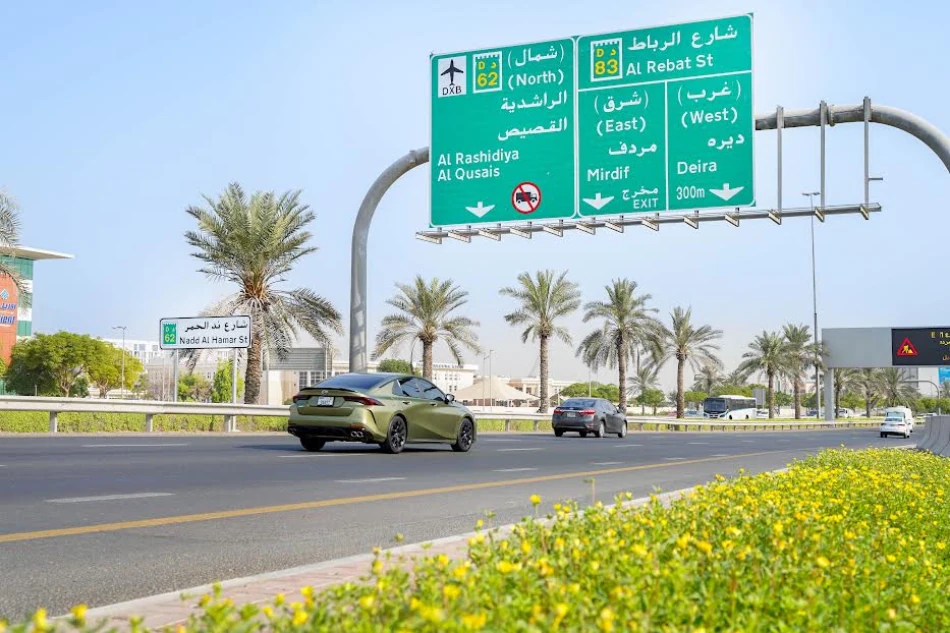
Dubai Roads Enhances Traffic Flow at Nad Al Hamr Intersection
Dubai Accelerates Infrastructure Push with Major Traffic Upgrade Ahead of Summer 2025
Dubai's Roads and Transport Authority (RTA) has launched a significant traffic infrastructure project that will increase vehicle capacity by 33% and cut travel times by nearly four minutes on key routes. The initiative, part of the emirate's rapid infrastructure improvements for 2025, demonstrates Dubai's continued commitment to maintaining its competitive edge as a global business hub through world-class transportation networks.
The Infrastructure Expansion Details
The RTA has begun implementing a new 850-meter vehicle route from Ras Al Khor Street toward the Nad Al Hamar intersection, near Nasser bin Lootah Mosque. Additionally, the authority is expanding storage lanes at the Nad Al Hamar intersection for vehicles coming from Al Rabat Street turning left into the Nad Al Hamar area.
The project is scheduled for completion by the end of August 2025, forming a crucial component of Dubai's Summer 2025 improvement plan. This timeline suggests the emirate is preparing its infrastructure for increased activity during the traditionally busy summer months, when residents and businesses rely heavily on efficient transportation networks.
Measurable Impact on Traffic Flow
Capacity and Time Savings
The new route will dramatically increase the area's vehicle capacity from 4,800 to 6,400 vehicles per hour—a 33% improvement that addresses one of urban planning's most persistent challenges. More significantly for daily commuters, travel times will drop from 15 minutes to 11 minutes, representing a 27% improvement in traffic flow efficiency, particularly during evening rush hours.
These aren't marginal gains. In a city where time efficiency directly correlates with economic productivity, saving four minutes per journey translates to substantial economic benefits when multiplied across thousands of daily commuters and commercial vehicles.
Strategic Geographic Connectivity
The expansion strategically serves vehicles heading to Nad Al Hamar and surrounding areas, including Al Rashidiya, Al Qusais, and Dubai International Airport. This connectivity pattern reveals Dubai's systematic approach to infrastructure development—rather than isolated improvements, the RTA is enhancing links between residential neighborhoods, commercial districts, and critical infrastructure like the airport.
The inclusion of Dubai International Airport in the beneficiary areas is particularly significant, as efficient airport access remains crucial for Dubai's position as a global aviation hub and business gateway to the Middle East and South Asia.
Dubai's Infrastructure Philosophy in Practice
Proactive Rather Than Reactive
Unlike many cities that expand infrastructure in response to congestion crises, Dubai continues to demonstrate its proactive approach. The emirate consistently invests in transportation improvements before bottlenecks become critical, maintaining its reputation for efficient urban mobility that attracts international businesses and residents.
This strategy mirrors successful infrastructure policies in Singapore and parts of China, where governments prioritize transportation efficiency as an economic competitiveness factor rather than merely a public service.
Integration with Broader Vision
The project aligns with Dubai's stated goal of achieving "global leadership in easy and sustainable mobility." While the sustainability aspect isn't detailed in this specific project, the efficiency improvements reduce fuel consumption and emissions through decreased idle time and smoother traffic flow.
For investors and businesses evaluating Dubai as a regional base, such infrastructure commitments signal governmental stability and long-term planning capability—factors that influence corporate location decisions and property investment strategies.
Most Viewed News

 Sara Khaled
Sara Khaled






